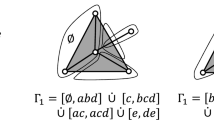Abstract
The approach emerging from the algebraic topology known by the Q-analysis (or Polyhedral Dynamics) method proposed by R.H. Atkin for the analysis of the structures of complex systems as well as for the measurement of the structural complexity of systems, has given rise to several works and applications in various fields. In this paper, we specifically develop a new hierarchical analysis method in the field of topological data analysis and explore its promising implications and results for the study of complex systems. Our method concerns systems governed by fuzzy connectivities and generalizes in some way the classical polyhedral dynamics approach and it is based on fuzzy path algebra and simplicial complexes. The presented system is a general framework that can be applied to various case studies of complex systems to aid in understanding their topology and logic. Results present, in a general way, the strengths and contribution of this method as well as its relevance for the analysis of complex systems.
This work was partially funded by Ministry of Equipment, Transport, Logistics and Water – Kingdom of Morocco, The National Road Safety Agency (NARSA) and National Center for Scientific and Technical Research (CNRST). Road Safety Research Program# An intelligent reactive abductive system and intui-tionist fuzzy logical reasoning for dangerousness of driver-pedestrians interactions analysis: Development of new pedestrians’ exposure to risk of road accident measures.
Access this chapter
Tax calculation will be finalised at checkout
Purchases are for personal use only
Similar content being viewed by others
References
Alexandroff, P.S.: Elementary Concepts of Topology. Dover Publications, N.Y. (1961)
Atkin, R.H.: An algebra for patterns on a complex, II. Int. J. Man Mach. Stud. 8, 483–498 (1976)
Atkin, R.H.: Combinatorial Connectivities in Social Systems. Birkhauser, Basel (1977)
Atkin, R.H.: From cohomology in physics to q-connectivity in social science. Int. J. Man Mach. Stud. 4, 139–167 (1972)
Atkin, R.H.: Mathematical Structure in Human Affairs. Heinemann, London (1974)
Bloch, I.: Fuzzy connectivity and mathematical morphology. Pattern Recogn. Lett. 14, 483–488 (1993). (North-Holland)
Boulmakoul, A., Besri, Z.: Performing enterprise organizational structure redesign through structural analysis and simplicial complexes framework. Open Oper. Res. J. 7, 11–24 (2013)
Boulmakoul, A., Idri, A., Marghoubi, R.: Closed frequent itemsets mining and struc-turing association rules based on q-analysis. In: 2007 IEEE International Symposiumon Signal Processing and Information Technology, pp. 519–524. IEEE (2007)
Chamorro-Martínez, J., Sánchez, D., Soto-Hidalgo, J.M., Martínez-Jiménez, P.M.: A discussion on fuzzy cardinality and quantification. Some Appl. Image Process. Fuzzy Sets Syst. 257, 85–101 (2014)
Chazal, F., Michel, B.: An introduction to topological data analysis: fundamental and practical aspects for data scientists. arXiv preprint (2017)
Horak, D., Maleti ́c, S., Rajkovi ́c, M.: Persistent homology of complex networks. J. Stat. Mech.: Theory Exper. 2009(03), P03034 (2009)
Edelsbrunner, H., Letscher, D., Zomorodian, A.: Topological persistence and simplification. In: Proceedings 41st Annual Symposium on Foundations of Computer Science, pp. 454–463. IEEE (2000)
El-Ghoul, M., El-Zohny, H., Radwan, S.: Fuzzy incidence matrix of fuzzy simplicial complexes and its folding. Chaos, Solitons Fractals 13(9), 1827–1833 (2002)
El-Ghoul, M.: Folding of fuzzy torus and fuzzy graphs Fuzzy Sets and System. Germany 80, 389–396 (1996)
Faridi, S.: The facet ideal of a simplicial complex. Manuscripta Math. 109(2), 159–174 (2002)
Ferrario, D.L., Piccinini, R.A.: Simplicial Structures in Topology, CMS Books in Mathematics Springer (2011). https://doi.org/10.1007/978-1-4419-7236-1
Giblin, P.J.: Graphs, Surfaces, and Homology: An Introduction to Algebraic Topology. Wiley, New York (1977)
Glazek, K.: A Guide to the Literature on Semirings and their Applications in Mathematics and Information Sciences: With Complete Bibliography, Springer Science & Business Media, June 29 (2013). https://doi.org/10.1007/978-94-015-9964-1
Jonsson, J.: Simplicial Complexes of Graphs, Lecture Notes in Mathematics. Springer (2008). https://doi.org/10.1007/978-3-540-75859-4
Maguerra, S., Boulmakoul, A., Karim, L., Badir, H.: A distributed execution pipeline for clustering trajectories based on a fuzzy similarity relation. Algorithms 12(2), 29 (2019)
Maleti ́c, S., Zhao, Y., Rajkovi ́c, M.: Persistent topological features of dynamical systems. Chaos: Interdiscip. J. Nonlinear Sci. 26(5), 053105 (2016)
Mordeson, J.N., Nair, P.S. (eds.): Fuzzy Graphs and Fuzzy Hypergraphs. Physica-Verlag HD, Heidelberg (2000)
Otter, N., Porter, M.A., Tillmann, U., Grindrod, P., Harrington, H.A.: A roadmap for the computation of persistent homology. EPJ Data Science 6(1), 1–38 (2017). https://doi.org/10.1140/epjds/s13688-017-0109-5
Slobodan, M., Milan, R.: Combinatorial Laplacian and entropy of simplicial complexes associated with complex networks. Euro. Phys. J. ST 212, 77–97 (2012)
Topaz, C.M., Ziegelmeier, L., Halverson, T.: Topological data analysis of biological aggregation models. PLoS ONE 10(5), e0126383 (2015)
Lin, T.Y., Chiang, I.J.: A simplicial complex, a hypergraph, structure in the latent semantic space of document clustering. Int. J. Approx. Reason. 40(1–2), 55–80 (2005)
Vick, J.W.: Homology Theory: An Introduction to Algebraic Topology (Graduate Texts in Mathematics) (v. 145) 2nd edn. Springer (1994). https://doi.org/10.1007/978-1-4612-0881-5
Wasserman, L.: Topological data analysis. Ann. Rev. Stat. Appl. 5, 501–532 (2018)
Zadeh, L.A.: Computational approach to fuzzy quantifiers in natural languages. Comput. Math. Appl. 9(1), 149–184 (1983)
Zadeh, L.A.: Fuzzy sets, Information and Control, vol. 8, Issue 3, June 1965, pp. 338–353 (1965)
Zadeh, L.A.: Similarity relations and fuzzy orderings. Inf. Sci. 3(2), 177–200 (1971)
Author information
Authors and Affiliations
Editor information
Editors and Affiliations
Rights and permissions
Copyright information
© 2022 The Author(s), under exclusive license to Springer Nature Switzerland AG
About this paper
Cite this paper
Boulmakoul, A., Ouifak, H., Karim, L., Lbath, A. (2022). Hierarchical Decomposition by Means of Fuzzy Simplicial Complexes. In: Kahraman, C., Cebi, S., Cevik Onar, S., Oztaysi, B., Tolga, A.C., Sari, I.U. (eds) Intelligent and Fuzzy Techniques for Emerging Conditions and Digital Transformation. INFUS 2021. Lecture Notes in Networks and Systems, vol 307. Springer, Cham. https://doi.org/10.1007/978-3-030-85626-7_26
Download citation
DOI: https://doi.org/10.1007/978-3-030-85626-7_26
Published:
Publisher Name: Springer, Cham
Print ISBN: 978-3-030-85625-0
Online ISBN: 978-3-030-85626-7
eBook Packages: Intelligent Technologies and RoboticsIntelligent Technologies and Robotics (R0)




